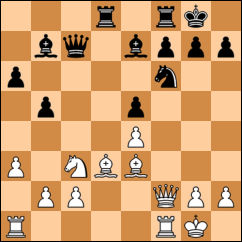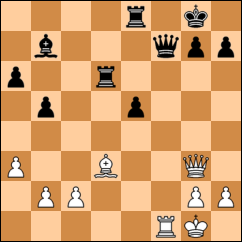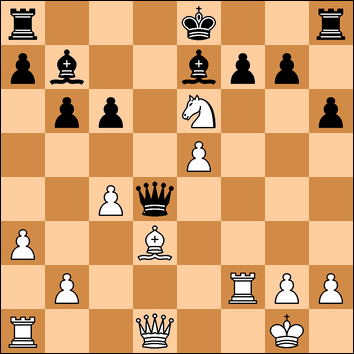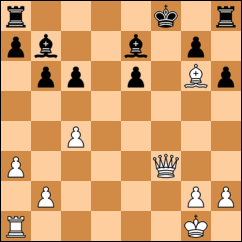A QUEEN'S NIGHT OFF
Date: 26 July 2000
Place: Cafe, Kulliyyah of Economy, International Islamic University, Malaysia
Time: 9.00 p.m.
I bet not many of you like to play without the powerful Queen. However, I experienced a particular night when I played all of my games without Her Majesty! Here are the games.
SICILIAN DEFENSE [B80]
W: Mumtaz Muhammad
B: Yours Truly!
The first game I play against the best IIUM female player. She plays rather the line that I myself play as White. Very quickly I have the advantage over her but I miss several chances to win the game.
1.e4 c5 2.Nf3 d6 3.d4 cxd4 4.Nxd4 Nf6 5.Nc3 a6 Najdorf Variation, named after a Polish-Argentine Grandmaster Miguel Najdorf, characterized by this mysterious pawn move which serves several purpose: 1) prevents a White piece landing on b5, 2) prepares b5 seeking to attack the knight on c3, and 3) a kind of waiting move when Black has not committed the e-pawn yet, giving flexibility.
6.Be3 Another viable moves here are 6.Bc4, 6.Bg5, 6.Be2, 6.a4, 6.f4, or 6.g3
6...e6 More aggressive is 6... e5 - more to the spirit of Najdorf Variation actually - when Black takes control of the d4 square and drives White's knight to less effective squares.
7.f3 Be7 8.Qd2 0–0 9.Be2 White gets mix up the idea of f3 and castle Kingside. More to the point here is 9.0–0–0 and storms Black's Kingside with pawns.
9...Qc7 10.a3?! An unnecessary pawn move. Black hasn’t try to undermine the c3-knight yet, nor does he try to land a piece on b4!
10...Nc6 11.0–0 Castle Kingside makes the move 7.f3 dubious. Why not moving f2-f4 in one move?
11...b5 This move is not necessary since White has already committed his pawn to a3. 11... Bd7 is clearly better. [11...Bd7 12.Nxc6 Bxc6 13.Bd4]
12.f4 Nxd4 13.Bxd4 e5 14.fxe5 This exchange gives Black the opportunity to get rid of his weak pawn on d6. 14.Bf2!? should be investigated more closely.
14...dxe5 15.Be3 Bb7 Attacks the isolated pawn on e4.
16.Bd3 Rad8 17.Qf2? Qe2 would keep White in the game. Now Black has a great chance to win with 17...Ng4! 18.Bb6 Qd6! 19.Bxd8 Nxf2 20.Bxe7 Nh3+ 21.gxh3 Qxe7.
Date: 26 July 2000
Place: Cafe, Kulliyyah of Economy, International Islamic University, Malaysia
Time: 9.00 p.m.
I bet not many of you like to play without the powerful Queen. However, I experienced a particular night when I played all of my games without Her Majesty! Here are the games.
SICILIAN DEFENSE [B80]
W: Mumtaz Muhammad
B: Yours Truly!
The first game I play against the best IIUM female player. She plays rather the line that I myself play as White. Very quickly I have the advantage over her but I miss several chances to win the game.
1.e4 c5 2.Nf3 d6 3.d4 cxd4 4.Nxd4 Nf6 5.Nc3 a6 Najdorf Variation, named after a Polish-Argentine Grandmaster Miguel Najdorf, characterized by this mysterious pawn move which serves several purpose: 1) prevents a White piece landing on b5, 2) prepares b5 seeking to attack the knight on c3, and 3) a kind of waiting move when Black has not committed the e-pawn yet, giving flexibility.
6.Be3 Another viable moves here are 6.Bc4, 6.Bg5, 6.Be2, 6.a4, 6.f4, or 6.g3
6...e6 More aggressive is 6... e5 - more to the spirit of Najdorf Variation actually - when Black takes control of the d4 square and drives White's knight to less effective squares.
7.f3 Be7 8.Qd2 0–0 9.Be2 White gets mix up the idea of f3 and castle Kingside. More to the point here is 9.0–0–0 and storms Black's Kingside with pawns.
9...Qc7 10.a3?! An unnecessary pawn move. Black hasn’t try to undermine the c3-knight yet, nor does he try to land a piece on b4!
10...Nc6 11.0–0 Castle Kingside makes the move 7.f3 dubious. Why not moving f2-f4 in one move?
11...b5 This move is not necessary since White has already committed his pawn to a3. 11... Bd7 is clearly better. [11...Bd7 12.Nxc6 Bxc6 13.Bd4]
12.f4 Nxd4 13.Bxd4 e5 14.fxe5 This exchange gives Black the opportunity to get rid of his weak pawn on d6. 14.Bf2!? should be investigated more closely.
14...dxe5 15.Be3 Bb7 Attacks the isolated pawn on e4.
16.Bd3 Rad8 17.Qf2? Qe2 would keep White in the game. Now Black has a great chance to win with 17...Ng4! 18.Bb6 Qd6! 19.Bxd8 Nxf2 20.Bxe7 Nh3+ 21.gxh3 Qxe7.

17...Qc6? However, this move gives the opponent counter play. Actually, I didn’t see that White do not have the time to take the rook without losing his precious queen. (See above notation)
18.Qg3 Bc5 19.Rae1 Bxe3+ 20.Rxe3 Rfe8 21.Ref3 Rd6 22.Nd5? This move concedes a pawn. Better is to get the King out of the fatal g1-a7 diagonal with 22.Kh1.
22...Nxd5 23.exd5 Qxd5? Releasing the pressure on the opponent. Black should have played 23...Qc5+ (this check couldn’t be played had White plays his king out of the diagonal) 24.Re3 Bxd5 defending the f7-pawn with the bishop rather than the queen.
24.Rxf7 Qxf7 Better is 24...g6!? and Black has air to breath 25.Qf2 Rdd8.
18.Qg3 Bc5 19.Rae1 Bxe3+ 20.Rxe3 Rfe8 21.Ref3 Rd6 22.Nd5? This move concedes a pawn. Better is to get the King out of the fatal g1-a7 diagonal with 22.Kh1.
22...Nxd5 23.exd5 Qxd5? Releasing the pressure on the opponent. Black should have played 23...Qc5+ (this check couldn’t be played had White plays his king out of the diagonal) 24.Re3 Bxd5 defending the f7-pawn with the bishop rather than the queen.
24.Rxf7 Qxf7 Better is 24...g6!? and Black has air to breath 25.Qf2 Rdd8.

25.Rxf7 White has let it slip away. She should try 25.Bxh7+ Kf8 26.Rxf7+ Kxf7 27.Qf2+ Ke7 28.Qa7 Rd1+ 29.Kf2 with a slight advantage to White.
25...Kxf7 and draws a few moves later.
25...Kxf7 and draws a few moves later.
CARO KANN DEFENSE [B17]
W: Shamsuddin Baguilan
B: Yours Truly
The second game I play against a good Philippino player. I just don’t feel like playing a Sicilian game that night and chose to play the Caro Kann instead.
1.e4 c6 I’m a dedicated Sicilian player, but in training I play almost everything. The Caro Kann is the most solid defense against 1.e4.
2.d4 d5 3.Nc3 dxe4 4.Nxe4 Nd7 5.Bd3 More usual here is 5.Nf3 or 5.Bc4.
5...Ngf6 6.f3 e6 7.Bg5 7.Ne2!? has some apparent merit. However, the text is also playable.
7...Be7 7...Qb6 is too brutal 8.Ne2 c5 9.dxc5 Qxb2 10.Bxf6 gxf6 11.Rb1 with unbalance position.
8.Ne2 h6 9.Be3 Nd5 10.Bf2 N7f6 11.0–0 b6 12.a3 Bb7 13.c4 Nxe4 14.fxe4 Nf6 15.e5 This move forces White to part with one of his bishop. More aggressive is 15.Nf4 g5 16.Nh5 Nxh5 17.Qxh5 Bf6 and White can smile.
15...Ng4 16.Nf4 Setting a trap. Too late did I recognize it only after I took the bait.
16...Nxf2 17.Rxf2 Qxd4? 17...Qd7!? must be considered 18.Qh5 Rf8. Black soon regrets his greediness.
18.Nxe6! The threat on the queen makes this knight immune.
W: Shamsuddin Baguilan
B: Yours Truly
The second game I play against a good Philippino player. I just don’t feel like playing a Sicilian game that night and chose to play the Caro Kann instead.
1.e4 c6 I’m a dedicated Sicilian player, but in training I play almost everything. The Caro Kann is the most solid defense against 1.e4.
2.d4 d5 3.Nc3 dxe4 4.Nxe4 Nd7 5.Bd3 More usual here is 5.Nf3 or 5.Bc4.
5...Ngf6 6.f3 e6 7.Bg5 7.Ne2!? has some apparent merit. However, the text is also playable.
7...Be7 7...Qb6 is too brutal 8.Ne2 c5 9.dxc5 Qxb2 10.Bxf6 gxf6 11.Rb1 with unbalance position.
8.Ne2 h6 9.Be3 Nd5 10.Bf2 N7f6 11.0–0 b6 12.a3 Bb7 13.c4 Nxe4 14.fxe4 Nf6 15.e5 This move forces White to part with one of his bishop. More aggressive is 15.Nf4 g5 16.Nh5 Nxh5 17.Qxh5 Bf6 and White can smile.
15...Ng4 16.Nf4 Setting a trap. Too late did I recognize it only after I took the bait.
16...Nxf2 17.Rxf2 Qxd4? 17...Qd7!? must be considered 18.Qh5 Rf8. Black soon regrets his greediness.
18.Nxe6! The threat on the queen makes this knight immune.

18...Qxe5 19.Re2 Qxe6?? Leads to further unpleasantness. I was tempted to exchange the queen for two of White's pieces, without realizing that my king’s position was quite open. The alternative 19...Qd6 20.Nxg7+ Kd7 also doesn’t look good for Black.
20.Rxe6 fxe6 21.Bg6+! A devastating check. White is in total control.
21...Kf8 22.Qf3+?! White delays the win. He should play 22.Qd7!! and Black can safely resign.

22...Bf6 23.Rd1 Ke7 24.Qf4 e5 25.Qf5 Rhd8 26.Re1 Kd6 27.Bf7 Kc7 28.Rxe5 Bxe5?? 28...Rd6 and Black is still in the game 29.Bh5 Bc8.
29.Qxe5+ Rd6 30.b4 Kd7?? A blunder in a bad position. Maybe 30...c5 31.bxc5 bxc5 32.Qxc5+ Bc6 would hold for Black.
31.c5 bxc5? Better is 31...Rf6 and Black can hope to live 32.Bh5 Ba6.
32.bxc5 Rf6 33.Bh5 Raf8?? Yet another blunder which finishes the game quickly.
34.Bg4+ Kd8 35.Qb8+ Black resigns.
It is mate after 35… Ke7 36.Qxb7+ Kd8 37.Qd7#.
CHIGORIN DEFENSE [D02]
W: Mohd Azizul
B: Shamsuddin Baguilan
The third and last game of the night I chose to play something out of book right from the start. After slowly building up a sound attacking position, I let him slip into the camp with 17… Bd2. After winning a pawn, Black started to look menacing. When he had the opportunity to win my queen, he took it without any hesitation. However, three pieces is just too much for the queen to cope with.
1.Nf3 Nc6 2.d4 d5 3.e3 Bg4 4.Be2 Bxf3 5.Bxf3 Nf6 6.Nd2 e5 7.dxe5 Nxe5 8.Be2 Bd6 9.Nf3 c6 10.Nd4 g6 11.0–0 Qc7 12.b3 Ne4 13.Bb2 a6 14.f4 Nd7 15.c4 0–0–0? 16.Rc1 Bb4 17.cxd5 Bd2 18.Rc2 Bxe3+ 19.Kh1 Ndc5 20.b4 Rxd5 21.bxc5 Rhd8 22.Bc4 Ng3+?? 23.hxg3 Rh5+ 24.Qxh5 gxh5 25.Ne6!! Qd7 26.Nxd8 Kxd8 27.Be2 Qf5 28.Rd1+ Ke7 29.Rc4 Bf2 30.Bf3 Bxg3 31.Re4+ Black resigns.
W: Mohd Azizul
B: Shamsuddin Baguilan
The third and last game of the night I chose to play something out of book right from the start. After slowly building up a sound attacking position, I let him slip into the camp with 17… Bd2. After winning a pawn, Black started to look menacing. When he had the opportunity to win my queen, he took it without any hesitation. However, three pieces is just too much for the queen to cope with.
1.Nf3 Nc6 2.d4 d5 3.e3 Bg4 4.Be2 Bxf3 5.Bxf3 Nf6 6.Nd2 e5 7.dxe5 Nxe5 8.Be2 Bd6 9.Nf3 c6 10.Nd4 g6 11.0–0 Qc7 12.b3 Ne4 13.Bb2 a6 14.f4 Nd7 15.c4 0–0–0? 16.Rc1 Bb4 17.cxd5 Bd2 18.Rc2 Bxe3+ 19.Kh1 Ndc5 20.b4 Rxd5 21.bxc5 Rhd8 22.Bc4 Ng3+?? 23.hxg3 Rh5+ 24.Qxh5 gxh5 25.Ne6!! Qd7 26.Nxd8 Kxd8 27.Be2 Qf5 28.Rd1+ Ke7 29.Rc4 Bf2 30.Bf3 Bxg3 31.Re4+ Black resigns.

No comments:
Post a Comment